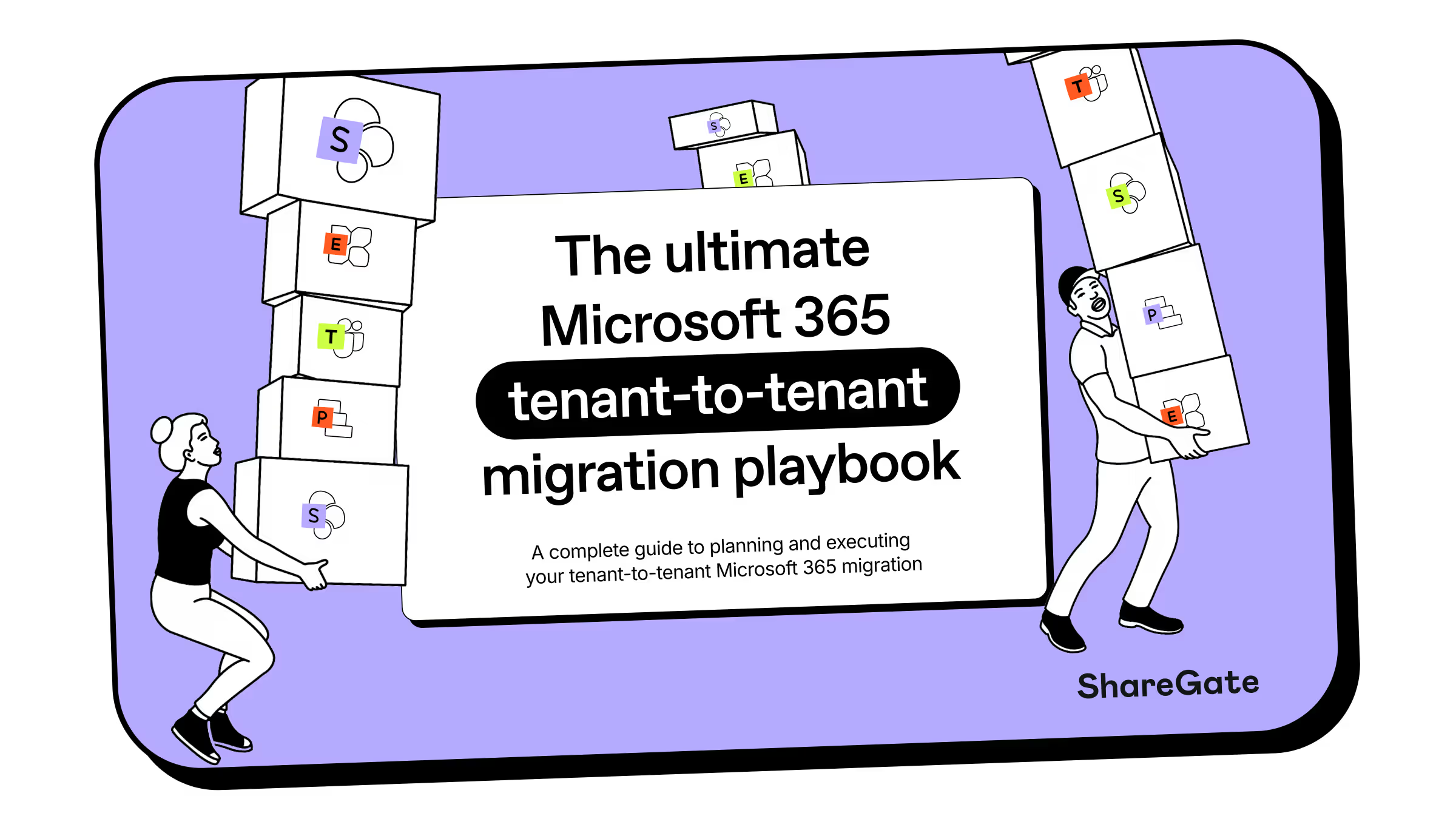Effective tenant-to-tenant migration: the ultimate playbook
Get the playbook for smooth migrations—whether you’re navigating a merger, acquisition, or reorganization. Master the process for SharePoint, Teams, and Exchange Online while taking it to the next level.

Tenant-to-tenant migration step by step—from the pros
As businesses evolve, Microsoft 365 tenant-to-tenant migrations are becoming essential, especially during mergers, acquisitions, divestitures, and reorganizations.
Check out answers to common migration questions and grab our ultimate playbook for expert insights and strategies for savvy IT pros!
%2520(1)%2520(1).avif)
Understanding tenant-to-tenant migrations in Microsoft 365
.avif)
What is it?
It means moving stuff between Microsoft 365 tenants, either moving from one to another (or to multiple tenants), splitting a tenant, or bringing two of them together.
When does it happen?
There are four basic scenarios when you need a tenant-to-tenant migration:
- Business mergers
- Business acquisitions
- Divestitures
- Business reorganization
To make sure your tenant-to-tenant migration runs smoothly, take the time to identify and fix potential issues before you get started. It will minimize the downtime and potential impact on your users, reduce risk, and make your new Microsoft 365 tenant much easier to manage and secure.
Planning your migration process
.avif)
What are the main risks while running a data transfer?
The key to a smooth tenant-to-tenant migration is solid planning. Anticipating risks and opportunities can help you avoid headaches later on.
Here are some of the main risks to consider before your Microsoft 365 migration process:
- Business discontinuity—Plan your migration to avoid disruptions, ensuring content, mailboxes, and workspaces are always available and functioning for everyone. For example, start with messages from six months or older first, use a tool that supports incremental migrations, and prioritize critical workloads.
- Productivity loss—Users should have instant access to their files, mailboxes, and documents right after the migration. Poor planning can cause delays, access issues, and productivity problems, especially if users aren’t properly trained in the new environment.
- Sprawl—Keep your environment clutter-free and relevant with proper settings, policies, and workspace provisioning. Prepare it for Copilot by tidying up and ensuring people have access to the right things.
How can I determine the time my migration will take?
There’s a plethora of factors that can impact migration time estimates. These are some of the main factors you should consider:
A good way to establish an approximate migration time? Run a test migration within your source environment. It will also help you determine what kind of challenges you might face and establish a more realistic migration plan.
Staying on top of group ownership and external sharing links will help you secure your data. So, remember to organize, update, and clean up both the source tenant and target tenant as part of your pre-migration planning. Collaborate with and involve stakeholders across the business. Make sure everyone understands the tasks and allows time for alignment on cleanup, archiving, organizing, modernizing, testing, and training.
ShareGate Migrate makes it easy to clean up your source tenant and destination environment. With the Quick actions menu, you can bulk edit content, modify the content of a list or library, download content to a local or shared drive, and much more.
Executing your tenant-to-tenant migration
.avif)
How can I ensure I’m migrating the right content?
A Microsoft 365 migration is a perfect opportunity to take stock of all content in your source tenant. By making a detailed inventory, you might find content that’s either duplicate, outdated, or no longer valid so that it can be archived and deleted before you transfer data unnecessarily to the target tenant.
An inventory of your source tenant is crucial to your migration process. It helps you make more informed decisions and estimate the required migration effort correctly.
How can I accelerate my migration project?
Consider the benefits of running concurrent migrations in parallel on different machines. It splits workloads across machines to keep things running smoothly and accelerates data throughput for faster migrations. Not to mention it mitigates Microsoft’s throttling!
How should I manage everyone else’s expectations?
Training and communication are essential to your Microsoft 365 tenant-to-tenant migration strategy. Before and during the migration process, everyone must be on the same page about what to expect while the work is done.
It’s important to manage your end users during a migration and communicate the benefits of this move. After the migration, provide training and support to drive Microsoft 365 adoption.
Okay, I’m ready to migrate. Where should I start?
Well, we won’t go into detail about it here. However, you’ll be glad to know we have many resources to help you every step of the way. Also, it’s a good idea to consider third-party migration and management tools like ShareGate to do the heavy lifting for you. Otherwise, you’ll be facing a very complex process.
Download our ultimate Microsoft 365 tenant-to-tenant migration playbook, then check out more helpful resources:
- SharePoint migration best practices
- SharePoint migration checklist
- Teams migration guide
- Teams migration checklist
- Microsoft 365 tenant-to-tenant migration with ShareGate
After your tenant-to-tenant migration
.avif)
How can I validate that I had a successful migration project?
There are a few steps you can take to validate that your migration was successful:
- Browse and verify your destination environments to make sure everything is in place.
- Ask users to validate that their content and data migration was done properly.
- Just in case, keep the source tenant for a few months after your migration.
- Look out for discrepancies between your tenants, like the number of items or their size.
- Guide users to use Microsoft 365 effectively, both through end-user training and good governance, to prevent sprawl and keep your environment secure.
How can I take action to manage my target tenant?
The first step is gaining visibility on your target tenant. Set up a reporting routine to stay on top of your new tenant. Using the report insights, you can manage permissions, check user activity, verify inactive teams, and ensure people use the tools correctly.
ShareGate provides you with actionable custom reports so you can have full visibility of your tenants and take action immediately. Check our full list of reports and explore our Microsoft 365 reporting guide to know all your options, including out-of-the-box Microsoft reports.

Migrate faster, transform smarter with ShareGate
.avif)
Microsoft 365 migration is SO much more than just lift and shift. ShareGate Migrate helps accelerate your migration project and guides you every step of the way, from planning and optimization to governance and Microsoft 365 end-user training.
Accelerated migrations
Hit that ‘migrate’ button on multiple machines in parallel to accelerate data throughput and mitigate Microsoft’s throttling.
Move and modernize with confidence
Maintain data integrity with every move while you transform with configurations that meet the needs of your unique environment.
Leave no best practice behind
Turn your migration project into a total success—right from the planning stages all the way through to Microsoft 365 end-user training.
Fixed costs
Predictable migration project management with unlimited end users, data, support, and workloads.
Our favorite thing: saving you time
About ShareGate Academy
ShareGate Academy is ShareGate’s learning platform. We offer free, online courses on all kinds of Microsoft 365 topics, from adoption to sprawl, from Microsoft Teams to SharePoint. ShareGate Academy is here to help IT pros expand their knowledge so they can work smarter, not harder.

.png)
.png)
.png)
